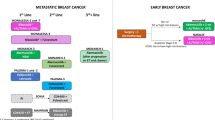The sensitivity of MDA-MB231 breast cancer cells to the effects of pharmacological agents was evaluated by their motility and viability. Dexamethasone, doxorubicin, or docetaxel administered separately in their effective concentration suppressed cell motility (in 16 h) and caused cell death (in 48 h). The strength of the effects increased in the following order: dexa methasone<doxorubicin≤docetaxel. The combined effects of the drugs were multidirectional: the total effect of dexamethasone and doxorubicin combination was inferior to their separate effect, while the effect of dexamethasone and docetaxel surpassed their individual effects. The combination of dexamethasone, doxorubicin, and docetaxel allowed negating the negative reciprocal interactions between dexamethasone and doxorubicin. The studying of the mechanisms underlying the observed phenomena attested to a potential role of S100A4 in the regulation of MDA-MB231 cells to the studied drugs.
Similar content being viewed by others
References
Dukhanina EA, Lukyanova TI, Romanova EA, Dukhanin AS, Sashchenko LP. Comparative analysis of secretion of S100A4 metastatic marker by immune and tumor cells. Bull. Exp. Biol. Med. 2008;145(1):78-80.
Al-Hajj M, Wicha MS, Benito-Hernandez A, Morrison SJ, Clarke MF. Prospective identification of tumorigenic breast cancer cells. Proc. Natl Acad. Sci. USA. 2003;100(7):3983-3988.
Bonadonna G, Valagussa P, Moliterni A, Zambetti M, Brambilla C. Adjuvant cyclophosphamide, methotrexate, and fluorouracil in node-positive breast cancer: the results of 20 years of follow-up. N. Engl. J. Med. 1995;332(14):901-906.
Chen A, Wang L, Li BY, Sherman J, Ryu JE, Hamamura K, Liu Y, Nakshatri H, Yokota H. Reduction in migratory phenotype in a metastasized breast cancer cell line via downregulation of S100A4 and GRM3. Sci. Rep. 2017;7(1):3459. doi: https://doi.org/10.1038/s41598-017-03811-9.
Dukhanina EA, Lukyanova TI, Romanova EA, Guerriero V, Gnuchev NV, Georgiev GP, Yashin DV, Sashchenko LP. A new role for PGRP-S (Tag7) in immune defense: lymphocyte migration is induced by a chemoattractant complex of Tag7 with Mts1. Cell Cycle. 2015;14(22):3635-3643.
Dukhanina EA, Portseva TN, Pankratova EV, Soshnikova NV, Stepchenko AG, Dukhanin AS, Georgieva SG. Oct-1 modifies S100A4 exchange between intra- and extracellular compartments in Namalwa cells and increases their sensitivity to glucocorticoids. Cell Cycle. 2016;15(11):1471-1478.
Early Breast Cancer Trialists’ Collaborative Group (EBCTCG), Peto R, Davies C, Godwin J, Gray R, Pan HC, Clarke M, Cutter D, Darby S, McGale P, Taylor C, Wang YC, Bergh J, Di Leo A, Albain K, Swain S, Piccart M, Pritchard K. Comparisons between different polychemotherapy regimens for early breast cancer: meta-analyses of long-term outcome among 100,000 women in 123 randomised trials. Lancet. 2012;379:432-444.
Gianni L, Norton L, Wolmark N, Suter TM, Bonadonna G, Hortobagyi GN. Role of anthracyclines in the treatment of early breast cancer. J. Clin. Oncol. 2009;27(28):4798-4808.
Ismail NI, Kaur G, Hashim H, Hassan MS. S100A4 overexpression proves to be independent marker for breast cancer progression. Cancer Cell Int. 2008;8:12. doi: https://doi.org/10.1186/1475-2867-8-12.
Ouyang M, Li Y, Ye S, Ma J, Lu L, Lv W, Chang G, Li X, Li Q, Wang S, Wang W. MicroRNA profiling implies new markers of chemoresistance of triple-negative breast cancer. PLoS One. 2014;9(5):e96228. doi: https://doi.org/10.1371/journal.pone.0096228.
Pai VB, Nahata MC. Cardiotoxicity of chemotherapeutic agents: incidence, treatment and prevention. Drug Saf. 2000; 22(4):263-302.
Redondo M, Téllez T, Roldan M. J, Serrano A, García-Aranda M, Gleave ME, Hortas ML, Morell M. Anticlusterin treatment of breast cancer cells increases the sensitivities of chemotherapy and tamoxifen and counteracts the inhibitory action of dexamethasone on chemotherapy-induced cytotoxicity. Breast Cancer Res. 2007;9(6):R86.
Siegel RL, Miller KD, Jemal A. Cancer statistics, 2016. CA Cancer J. Clin. 2016;66(1):7-30.
Wang Z, Griffin M. The role of TG2 in regulating S100A4-mediated mammary tumour cell migration. PLoS One. 2013; 8(3):e57017. doi: https://doi.org/10.1371/journal.pone.0057017.
Author information
Authors and Affiliations
Corresponding author
Additional information
Translated from Byulleten’ Eksperimental’noi Biologii i Meditsiny, Vol. 166, No. 7, pp. 62-65, July, 2018
Rights and permissions
About this article
Cite this article
Dukhanina, E.A., Portseva, T.N., Dukhanin, A.S. et al. Studying of the Mechanisms of Combined Effect of Dexamethasone, Doxorubicin, and Docetaxel on Breast Cancer Cells. Bull Exp Biol Med 166, 54–57 (2018). https://doi.org/10.1007/s10517-018-4288-2
Received:
Published:
Issue Date:
DOI: https://doi.org/10.1007/s10517-018-4288-2




